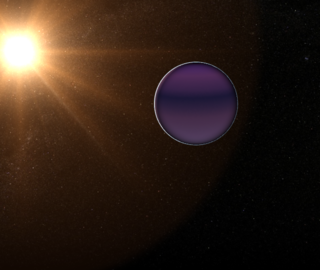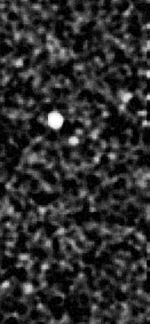Related Research Articles
HD 177830 is a 7th magnitude binary star system located approximately 205 light-years away in the constellation of Lyra. The primary star is slightly more massive than the Sun, but cooler being a type K star. Therefore, it is a subgiant clearly more evolved than the Sun. In visual light it is four times brighter than the Sun, but because of its distance, about 205 light years, it is not visible to the unaided eye. With binoculars it should be easily visible.

An eccentric Jupiter is a Jovian planet that orbits its star in an eccentric orbit. Eccentric Jupiters may disqualify a planetary system from having Earth-like planets in it, because a massive gas giant with an eccentric orbit may eject all Earth mass exoplanets from the habitable zone, if not from the system entirely.

HD 28185 b is an extrasolar planet 128 light-years away from Earth in the constellation of Eridanus. The planet was discovered orbiting the Sun-like star HD 28185 in April 2001 as a part of the CORALIE survey for southern extrasolar planets, and its existence was independently confirmed by the Magellan Planet Search Survey in 2008. HD 28185 b orbits its sun in a circular orbit that is at the inner edge of its star's habitable zone.
HD 217107 b is an extrasolar planet approximately 65 light-years away from Earth in the constellation of Pisces. The planet was discovered orbiting the star HD 217107 approximately every seven days, classifying the planet as a hot Jupiter. Because of the planet's somewhat eccentric orbit, scientists were able to confirm another planet within the system.

HD 217107 c is an extrasolar planet approximately 64 light-years away from Earth in the constellation of Pisces. The planet was the second planet to be discovered orbiting the star HD 217107. HD 217107 c's existence was hypothesized in 1998 due to the eccentricity of the inner planet's orbit and confirmed in 2005 when radial velocity studies of the star indicated another, more distant and massive companion orbiting the star. The planet has an eccentric orbit lasting on order of a decade.
HD 11964 b is an extrasolar planet, a gas giant like Jupiter approximately 110 light-years away in the constellation of Cetus. The planet orbits the yellow subgiant star HD 11964 in a nearly-circular orbit, taking over 5 years to complete a revolution around the star at a distance of 3.34 astronomical units.
HD 196050 b is an exoplanet with a 1378-day period and a minimum mass of 2.90 Jupiter masses. The average orbital distance is 2.54 astronomical units and the orbital eccentricity is 22.8%. The periastron (closest) distance is 1.96 AU and the apastron (farthest) distance is 3.12 AU. The average orbital velocity is 20.1 km/s and the semi-amplitude is 49.7 m/s. The longitude of periastron is 187° and the time of periastron is 2,450,843 JD.
HD 86081 b or Santamasa, meaning 'clouded' in Sanskrit, is a gas giant exoplanet that orbits close to its host star HD 86081 or Bibha, completing its orbit in only 2.1375 days. With such a short orbit it belongs to the class of exoplanets known as hot Jupiters. Like most Hot Jupiters, the orbit is nearly circular, with an eccentricity of 0.008. On 17 December 2019, the International Astronomical Union, Paris has selected the name 'Santamasa' suggested by 13 year old Vidyasagar Daud, class 8th student of Sinhgad Spring Dale Public School, Pune, India for the exoplanet HD 86081 b, This large scale election procedure has come up across India. The name echoes the Indian sentiments through the name 'Sant' (संत), 'Tamas' (तमस्) refers to "darkness", similarly the entire name 'Santamasa' matched with the characteristics of the exoplanet being clouded.

HD 76700 b is an exoplanet orbiting the G-type main sequence star HD 76700 approximately 198 light years away in the southern constellation Volans. The planet was discovered in 2002, and was announced in 2003.
HD 59686 Ab is an exoplanet that orbits the giant star HD 59686 A in a close binary star system. It has a nearly circular orbit with a period of 300 days and a semi-major axis of 1.09 AU, slightly greater than the distance between Earth and the Sun. It has a minimum mass 6.9 times that of Jupiter, with the true mass depending on the orbital inclination, which is not yet known. HD 59686 Ab was discovered by radial velocity and first announced in November 2003, but the discovery was not formally published until 2016.
HD 27894 b is a gas giant with a mass at least two thirds that of Jupiter, or twice that of Saturn. The distance from the planet to the star is one third compared that of Mercury from the Sun, and it takes almost exactly 18 days to complete one roughly circular orbit.
HD 192263 b, also named Beirut, is a gas giant planet with a mass about three quarters that of Jupiter mass. It orbits the star in a circular orbit completing one revolution in 24 days or so. It was discovered in 2000 by the Geneva Extrasolar Planet Search team. The planet was independently detected by the California and Carnegie Planet Search team.
HD 102117 b, formally named Leklsullun, is a planet that orbits the star HD 102117. The planet is a small gas giant a fifth the size of Jupiter. It orbits very close to its star, but not in a "torch orbit" like the famous 51 Pegasi b. It was one of the smallest extrasolar planets discovered as of 2006.
HD 40307 b is an extrasolar planet orbiting the star HD 40307, located 42 light-years away in the direction of the southern constellation Pictor. The planet was discovered by the radial velocity method, using the European Southern Observatory's HARPS apparatus, in June 2008. It is the second smallest of the planets orbiting the star, after HD 40307 e. The planet is of interest as this star has relatively low metallicity, supporting a hypothesis that different metallicities in protostars determine what kind of planets they will form.
HD 40307 c is an extrasolar planet orbiting the star HD 40307, located 42 light-years away in the direction of the southern constellation Pictor. The planet was discovered by the radial velocity method, using the HARPS apparatus, in June 2008. Of the six proposed planets in the HD 40307 star system, it is the third-largest, and has the second-closest orbit from the star. The planet is of interest as this star has relatively low metallicity, supporting a hypothesis that different metallicities in protostars determine what kind of planets they will form.
HD 40307 d is an extrasolar planet orbiting the star HD 40307, located 42 light-years from Earth in the direction of the southern constellation Pictor. The planet was discovered by the radial velocity method, using the HARPS apparatus in June 2008. It is the most massive of the six proposed planets in the system. The planet is of interest as this star has relatively low metallicity, supporting a hypothesis that different metallicities in protostars determine what kind of planets they will form.
HD 212771 b is an extrasolar planet orbiting the G-type star HD 212771 approximately 364 light years away in the constellation Aquarius.

An exoplanet is a planet located outside the Solar System. The first evidence of an exoplanet was noted as early as 1917, but was not recognized as such until 2016; no planet discovery has yet come from that evidence. What turned out to be the first detection of an exoplanet was published among a list of possible candidates in 1988, though not confirmed until 2003. The first confirmed detection came in 1992, with the discovery of terrestrial-mass planets orbiting the pulsar PSR B1257+12. The first confirmation of an exoplanet orbiting a main-sequence star was made in 1995, when a giant planet was found in a four-day orbit around the nearby star 51 Pegasi. Some exoplanets have been imaged directly by telescopes, but the vast majority have been detected through indirect methods, such as the transit method and the radial-velocity method. As of 1 December 2023, there are 5,550 confirmed exoplanets in 4,089 planetary systems, with 887 systems having more than one planet. This is a list of the most notable discoveries.
HD 219134 g, also known as HR 8832 g, is an unconfirmed exoplanet orbiting around the K-type star HD 219134 in the constellation of Cassiopeia. It has a minimum mass of 11 or 15 Earth masses, suggesting that it is likely a Neptune-like ice giant. Unlike HD 219134 b and HD 219134 c it is not observed to transit and thus its radius and density are unknown. If it has an Earth-like composition, it would have a radius 1.9 times that of Earth. However, since it is probably a Neptune-like planet, it is likely larger.

HD 89345 b is a Neptune-like exoplanet that orbits a G-type star. It is also called K2-234b. Its mass is 35.7 Earths, it takes 11.8 days to complete one orbit of its star, and is 0.105 AU from its star. It was discovered by 43 astrophysicists, one which is V. Van Eylen, and is announced in 2018.
References
- 1 2 Fischer, Debra A.; et al. (1999). "Planetary Companions around Two Solar-Type Stars: HD 195019 and HD 217107". Publications of the Astronomical Society of the Pacific. 111 (755): 50–56. arXiv: astro-ph/9810420 . Bibcode:1999PASP..111...50F. doi:10.1086/316304. S2CID 17980987.